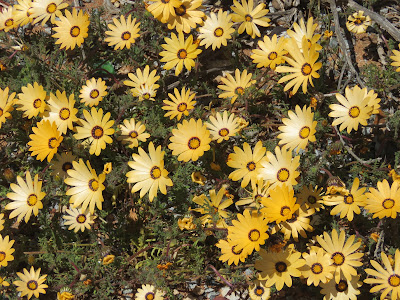In order to fully comprehend the magnitude of the problem of identifying fynbos flowers one needs to be aware that there are at least 8500 species and the book that I use covers 1100 of the more common ones. So even if the picture resembles what I'm looking at, it is quite likely that there are half a dozen others that look similar. Nevertheless I will endeavor to do my best. In the last post I included a picture of a field of these pretty little daisies which I was unable to name because the book was in the Beast who was being repaired, but even though we are not yet reunited, I have managed to secure said book and can thus tell you that these are Livingstone daisies Dorotheantus bellidiformis.
Likewise a species encountered on Bainskloof Pass that I very mistakenly thought to be an erica, is in fact a Blue pea Psoralea affinis
Moving on to some new delights, I found a little patch of these Yellow-eyed sorrel Oxalis obtusa, by the side of a back-road near Melkbos and think they have to be one of the most beautiful flowers that I have seen. Only about 20 mm diameter and standing all of 40 mm above very sandy soil, the colour combination is simply perfect.
As the Beast was due to go in for repairs I headed into the Cederberg Mountains near Clanwilliam and spent a night a Traveller's Rest on the fringes of the Karoo. The area is not noted for them, so when you provide a couple of stout fever trees, the weavers couldn't be happier.
Here the flowers weren't arrayed en masse but move 10 m in any direction and you were bound to find something new, for example, a Wild violet Monopsis sp..........I think!
Desert primroses Grielum humifusum or Pietsnot in Afrikaans which even if it's not what I think it is, is a pretty disgusting name.
How about Painted petals, Lapeirousia fabricii......
.................or Lady's hand Cyanella orchidiformis............
.................or Persmalva (don't ask) Pelagonium magentium............................
......................or another Ruschia species, it's just mind-blowing.
An afternoon birding drive took me to the top of a pass overlooking the Doringbos valley, with the endless reaches of the Karoo that were unbelievably verdant.
A plant which is common in the Karoo is the Yellow milk-bush Euphorbia mauritanica but I had never seen them absolutely plastered with blossom.
The cottage I was in was away from it all and bathed in the silence that only the Karoo can provide, while the stars in night sky felt as though they were within touching distance.
On a chilly walk the next morning I happened on a clump of the weirdest flowers I've ever laid eyes on. It is one of the 70 species the twinspur family Diascia. The open part of the flower was about 25 mm diameter with a pair of backward facing tubes 40 mm long that contain an oil which is collected by a genus of bees that have unusually long forelegs and probably evolved with the plants. Thought the dew drops were a nice touch!
And 5 paces to the left, a perskalkoentjie Gladiolus venustus! The literal translation is press turkey and may have arisen because some of the group have red petals which dangle like pendulous turkey wattles but the exact reason seems lost in the mists of time.
The Cederberg Mountains are rugged in the extreme and there are literally thousands of rocks which appear to be one little nudge away from toppling.
With a bit of time to kill, I took the R363 from Klawer to Vredendal along the Olifants River, on past Lutzville and then the R362 to Strandfontein and the sea. Presumably the run-off from the road assisted these Gazania krebsiana and ......................
........and others such as ursinia and felicia to bloom as they were far more prolific on the verges than in the scrub-land.
Some of the colour combinations were elegant enough to have been laid out by a fastidious gardener.
There is a huge caravan park at Strandfontein where I spent almost a month 5 odd years ago and just up the beach from there, the Olifant's empties into the Atlantic.
Have mentioned previously how the flowers become almost invisible as they follow the sun and this was glaringly obvious on my return when I was gob-smacked by this lot. The petals of Ruschia caroli are so shiny that they reflect the sun and after much consultation, it was decided that the colour was deep magenta - trust Nick to come up with an app, thanks buddy.

As usual, the more you look - Gousblom or Dutch gold (the colour varies)
Arcototis hirsuta ...................
......................Parachute daisies Ursinia cakilefolia, often referred to as Namaqua daisies but there is no such thing in any of the books I have.........................
.....................and a stretch with hundreds of bushes of euryops, another member of the daisy family.
The next two nights were spent in a very comfortable self-catering establishment in Vanrhynsdorp at the foot of this massive buttress that is the gateway to the Kouebokkeveld.
From near the top of Vanrhyns Pass, it is all too evident that the devastating drought that has afflicted this region for many years has left vast swathes of the country desolate.
There is an area called Oorlogskloof Nature Reserve just outside Nieuwoudville which I have tired to find on a number of occasions without much success. There were fields covered with little daisies of senecio family......
.........and a tarn where black-winged stilts foraged in freezing water.................
............ a spot where Cape Town blues Felicia ameliodes were slowly unfurling................
.......................while nearby was one of the family known as bobbejaantjies, Babiana ambigua. A rather magnificent species of lily, whose flowers spring directly from the bulb but quite why they are called little baboons is a mystery, as is the whereabouts of Oorlogskloof.
































































